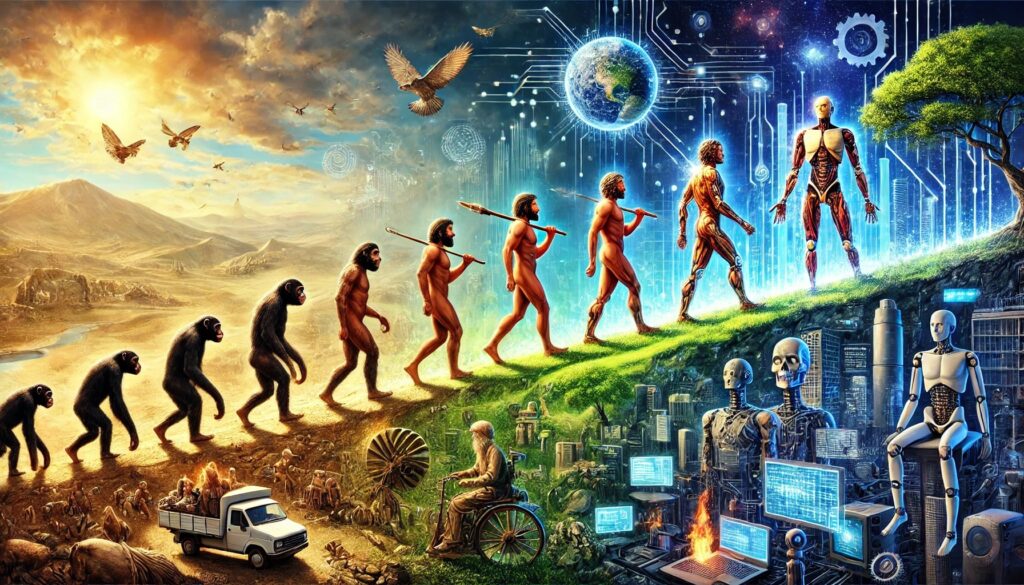Author: Yuval Noah Harari
Published: 2014
Genre: Non-fiction, History, Anthropology

Introduction
“Sapiens: A Brief History of Humankind” explores the evolution of Homo sapiens from insignificant primates to the dominant species on Earth. Harari examines the major revolutions—cognitive, agricultural, and scientific—that shaped human history. The book offers a blend of anthropology, history, and philosophy to explain how humans developed complex societies, cultures, and belief systems.
PART 1: The Cognitive Revolution (70,000 – 10,000 BCE)
This section explores how humans evolved from ordinary animals into the most influential species.
1. The Rise of Homo Sapiens
- Around 2.5 million years ago, multiple human species existed, including Homo erectus, Neanderthals, and Homo sapiens.
- Homo sapiens became the dominant species by around 70,000 years ago, outcompeting others.
2. The Cognitive Leap: Fiction & Language
- What set sapiens apart was the ability to create and believe in shared myths—stories that exist only in human imagination (e.g., gods, nations, money).
- Unlike other animals, humans could cooperate in large numbers because they shared beliefs in abstract concepts.
- Example: A lion might be dangerous, but believing in religions, laws, and money allowed humans to work together in ways no other species could.
3. Expansion & Extinction of Other Human Species
- This rapid expansion led to the extinction of many large animals, known as the First Wave of Extinction caused by humans.
- With superior communication and cooperation, sapiens spread across the world.
- They likely caused the extinction of Neanderthals and other human species.
PART 2: The Agricultural Revolution (10,000 BCE – 1500 CE)
A shift from hunting-gathering to farming changed human society forever.
4. The Farming Trap
- Early humans lived as hunter-gatherers, but around 10,000 BCE, they began domesticating plants and animals.
- Farming led to population growth, but it did not improve individual happiness.
- People worked harder than before, suffered from disease, malnutrition, and inequality, but couldn’t go back to hunting because they depended on farming.
5. The Birth of Cities and Hierarchies
- Farming led to permanent settlements, eventually growing into villages, towns, and cities.
- Social hierarchies formed—kings, priests, soldiers, and commoners.
- Gender roles became rigid as societies became patriarchal.
6. The Power of Shared Myths: Religion, Money, and Empires
- Harari argues that religions, nations, and economies are all based on collective human imagination.
- Example: Money has value only because we all believe in it.
- Large empires (like the Roman and Chinese Empires) were built on shared myths like religion, nationalism, and laws.
PART 3: The Unification of Humankind (1500 CE – Present)
Over time, humans became more interconnected through trade, wars, and globalization.
7. The Role of Money and Capitalism
- Money is the most universal belief system—accepted by all cultures.
- The rise of capitalism encouraged innovation, science, and economic growth.
- The Scientific Revolution (1500s onward) was driven by capitalism and exploration.
8. Religion and Nationalism
- Religions evolved to provide moral codes, uniting large populations.
- Nations are also imagined communities, just like money and religion.
- Globalization has created one interconnected world, where economic and political systems are linked.
PART 4: The Scientific Revolution (1500 CE – Present & Beyond)
The most significant shift in human history came with science, technology, and industry.
9. The Rise of Science & Exploration
- The Scientific Revolution (1500 CE onwards) changed how humans understood the world.
- Scientists started seeking knowledge and progress, rather than relying on religion.
- European powers used science to conquer the world (e.g., colonialism, the Industrial Revolution).
10. The Industrial Revolution & Modern Society
- The Industrial Revolution (1700s onwards) brought mass production, urbanization, and fossil fuel usage.
- This increased human power but also created problems like climate change and social inequality.
11. The Future: Artificial Intelligence & Genetic Engineering
- Harari questions whether Homo sapiens will continue evolving or be replaced by artificial intelligence and biotechnology.
- We may be heading toward a new species—Homo Deus (god-like humans), altering our biology and intelligence.
Conclusion: Where Are We Headed?
Harari leaves readers with two big questions:
- Are humans happier today than in the past? – Despite technological progress, happiness hasn’t necessarily increased.
- What is the future of humanity? – With AI and genetic engineering, we might no longer be the same species in the future.
Key Takeaways
✔ Human success is built on shared myths – religion, money, nations, laws.
✔ The Agricultural Revolution trapped humans, rather than freeing them.
✔ Capitalism and science fueled global development, but also created ethical dilemmas.
✔ Humanity is at a crossroads – we might become a new species with AI and genetic engineering.
Final Thoughts
“Sapiens” is a fascinating look at how we evolved from simple primates to rulers of the world. Harari’s key argument is that humans control the planet not because we are the strongest, but because we are the only species that can cooperate flexibly in large numbers.
As we enter the future of AI and biotechnology, will we remain Homo sapiens—or will we evolve into something entirely different?